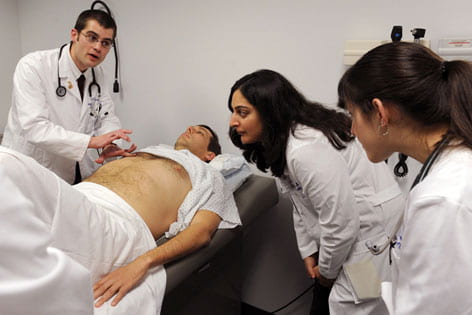Playing a patient

Kevin Kilmer is one sick guy — and the first patient many of UC Irvine’s first-year medical students ever see.
To them, he’s a 42-year-old man with a bad case of intestinal distress. But Kilmer is more than that. He’s at the heart of an innovative program that teaches medical students the basic exam techniques, diagnostic skills and compassionate bedside manner that will make them good doctors.
While Kilmer’s condition is based on an actual case, he’s a fictional character created by the standardized patient program at the School of Medicine’s Clinical Skills Center. As part of their training, all UCI medical students and residents interact with community members trained to portray patients simulating a wide spectrum of ailments.
“This program is the cornerstone of medical education,” says Dr. Gerald Maguire, senior associate dean of educational affairs. “As a doctor, you learn from your patients, and it’s important that our students learn to do the right things before we put them in a real clinical setting.”
In the mid-1990s, the medical school became one of the first to use standardized patient training. The safe, hands-on learning environment has dramatically improved students’ ability to diagnose illnesses, according to Sue Ahearn, Clinical Skills Center director. It also teaches them how to treat the person, not just the disease.
Hundreds of local residents portray the patients, receiving $15 to $20 an hour for their efforts. Some are actors and performers; all share a deep interest in medicine.
Former standardized patient Sharon Havis now works for the program creating patient case studies and training community members to bring them to life. In February, she invited me to play Kevin Kilmer for first-year medical students.
He’s one of the easier characters to portray, says Emil Yevdayev, an Irvine resident who’s played patients for nine years. A former UCI premed student, he spends about 20 hours a month performing at UCI, USC and UCLA medical schools.
Other cases, Yevdayev says, such as those for third-year medical students and residents, are more challenging. To portray an appendicitis patient, he says, “You need to have a certain breathing technique, almost to the point of hyperventilating. It makes a strong impact when the students see you as a real patient.”
Kilmer’s history and condition are not very detailed, so there was little to memorize. My job was to lay back and let dozens of medical students do a hands-on abdominal exam.
Havis and Yevdayev stressed that a standardized patient never falls out of character. No matter what happened in the exam room, I was to remain Kevin Kilmer.
Four groups of medical students, led by an instructor, spent 90 minutes each with me. I greeted each group with the same prepared line: “I sure hope you can give me something for this diarrhea.”
The students took Kilmer’s personal history — he’s homeless, smokes and drinks too much, and has hepatitis C, contracted through intravenous drug use.
Next they conducted an abdominal exam, checking intestinal sounds with a stethoscope, and performing palpations (pushing the fingertips into the body) and percussions (tapping firmly with the middle finger) to gauge the size of my liver. Being Kevin Kilmer is not for the ticklish.
The students learn how to talk to patients — to ask permission before performing hands-on exams, to inquire if patients are uncomfortable, to explain why tests are needed.
“Some students start trembling during these sessions,” says Dr. Sonia Sehgal, geriatrics assistant clinical professor. “But an amazing transition happens after the first year or two. They suddenly become capable of taking down very complex histories and are very sure of themselves.”
As for the cause of my, er, Kilmer’s ailment? The students determine it’s probably his poor diet and recommend he drink lots of fluids. If the symptoms continue, they recommend the patient return for a fecal test to see if anti-bacterial drugs are needed. I’m glad my stint as Kilmer is over.
Students continue seeing standardized patients throughout medical school and are graded on interviewing and diagnostic skills. They must pass detailed clinical exams before receiving their degrees.
“There are aspects to being a doctor you can’t learn from a book,” Sehgal says. “This is why standardized patients are so important. They dedicate their time and bodies, and they are phenomenal at being in character and giving feedback. Medical education is nothing without them.”
Originally published in Vol. 1, Iss. 5 ZotZine